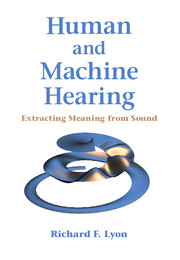Book contents
- Frontmatter
- Dedication
- Contents
- Foreword
- Preface
- Part I Sound Analysis and Representation Overview
- Part II Systems Theory for Hearing
- Part III The Auditory Periphery
- 13 Auditory Filter Models
- 14 Modeling the Cochlea
- 15 The CARFAC Digital Cochlear Model
- 16 The Cascade of Asymmetric Resonators
- 17 The Outer Hair Cell
- 18 The Inner Hair Cell
- 19 The AGC Loop Filter
- Part IV The Auditory Nervous System
- Part V Learning and Applications
- Bibliography
- Author Index
- Subject Index
- Plate section
13 - Auditory Filter Models
from Part III - The Auditory Periphery
Published online by Cambridge University Press: 28 April 2017
- Frontmatter
- Dedication
- Contents
- Foreword
- Preface
- Part I Sound Analysis and Representation Overview
- Part II Systems Theory for Hearing
- Part III The Auditory Periphery
- 13 Auditory Filter Models
- 14 Modeling the Cochlea
- 15 The CARFAC Digital Cochlear Model
- 16 The Cascade of Asymmetric Resonators
- 17 The Outer Hair Cell
- 18 The Inner Hair Cell
- 19 The AGC Loop Filter
- Part IV The Auditory Nervous System
- Part V Learning and Applications
- Bibliography
- Author Index
- Subject Index
- Plate section
Summary
The original aim of this research was to obtain a mathematical expression for the amplitude characteristic of the hypothetical auditory filter that could be used to predict the power that a tone must have to be just audible in the presence of a given noise.
– “Auditory filter shape,” Patterson (1974)The auditory filter may be considered as a weighting function representing frequency selectivity at a particular centre frequency. Its shape can be derived using the power-spectrum model of masking which assumes: (1) in detecting a signal in a masker the observer uses the single auditory filter giving the highest signal-to-masker ratio; (2) threshold corresponds to a fixed signal-to-masker ratio at the output of that filter.
– “Formulae describing frequency selectivity as a function of frequency and level, and their use in calculating excitation patterns,” Moore and Glasberg (1987)Over the last half century, many auditory filter models have been developed, analyzed, and applied to hearing-related problems. Linear filter models, along with more realistic quasi-linear level-dependent models, have been explored. We review several lines of development, and several criteria that filter models might try to satisfy, and show how the pole–zero filter cascade (PZFC) models achieve these desired properties.
Early attempts at describing auditory function by filters used three kinds of filter shapes: simple resonances, Gaussian filters, and rectangular filters. Most more modern auditory filter models can be seen as belonging to three main families (detailed in Section 13.4.1): the rounded exponential (roex) family, the gammatone family, and the filter cascade family. In many cases, independent efforts led to somewhat similar results, without necessarily sharing a name or any other relationship. I have discovered some of these relationships in retrospect, such as the early 1960s work by Jim Flanagan (1960, 1962) on gammatone, one-zero gammatone, and related pole– zero filter models of basilar membrane motion, long before the term gammatone was coined.
Transmission-line models of wave propagation on the basilar membrane go even further back, but the basis for approximating these systems as cascade-structured filter models was not made clear until after Zweig, Lipes, and Pierce (1976) showed how to apply theWentzel–Kramers–Brillouin (WKB) approximation in their 1976 “cochlear compromise” paper.
- Type
- Chapter
- Information
- Human and Machine HearingExtracting Meaning from Sound, pp. 239 - 264Publisher: Cambridge University PressPrint publication year: 2017



